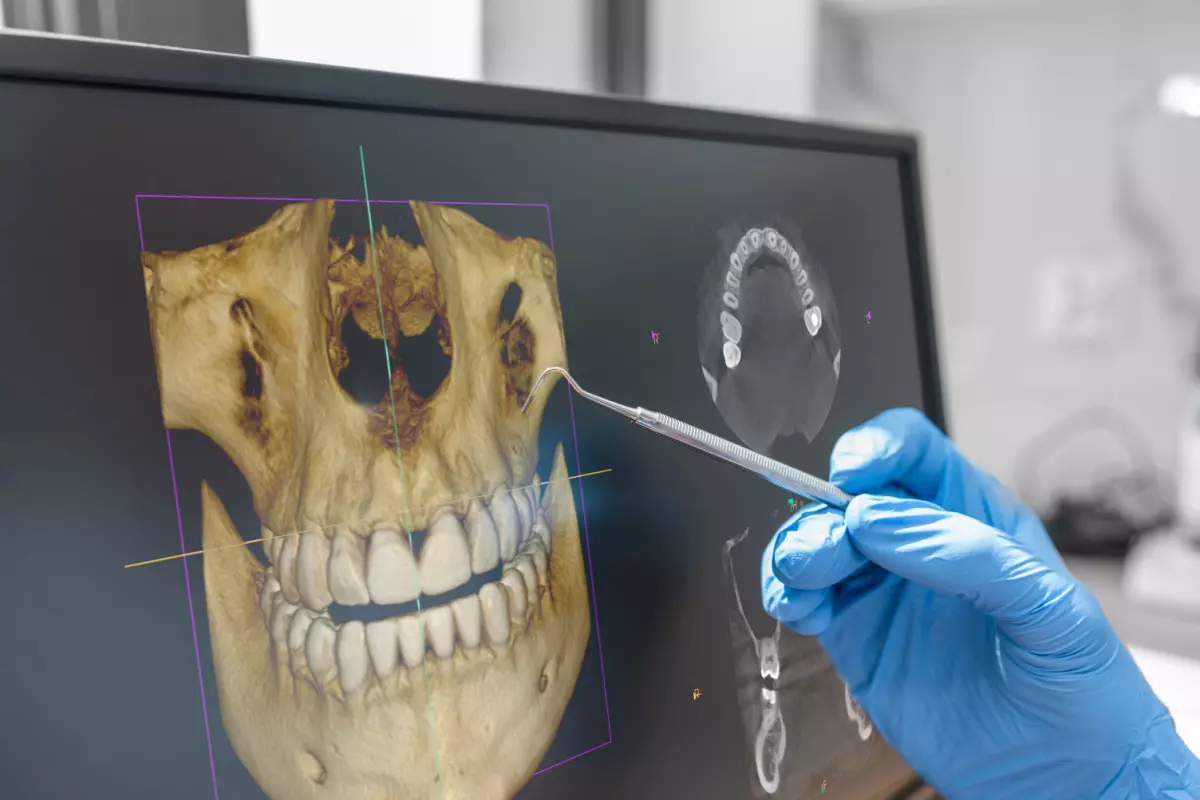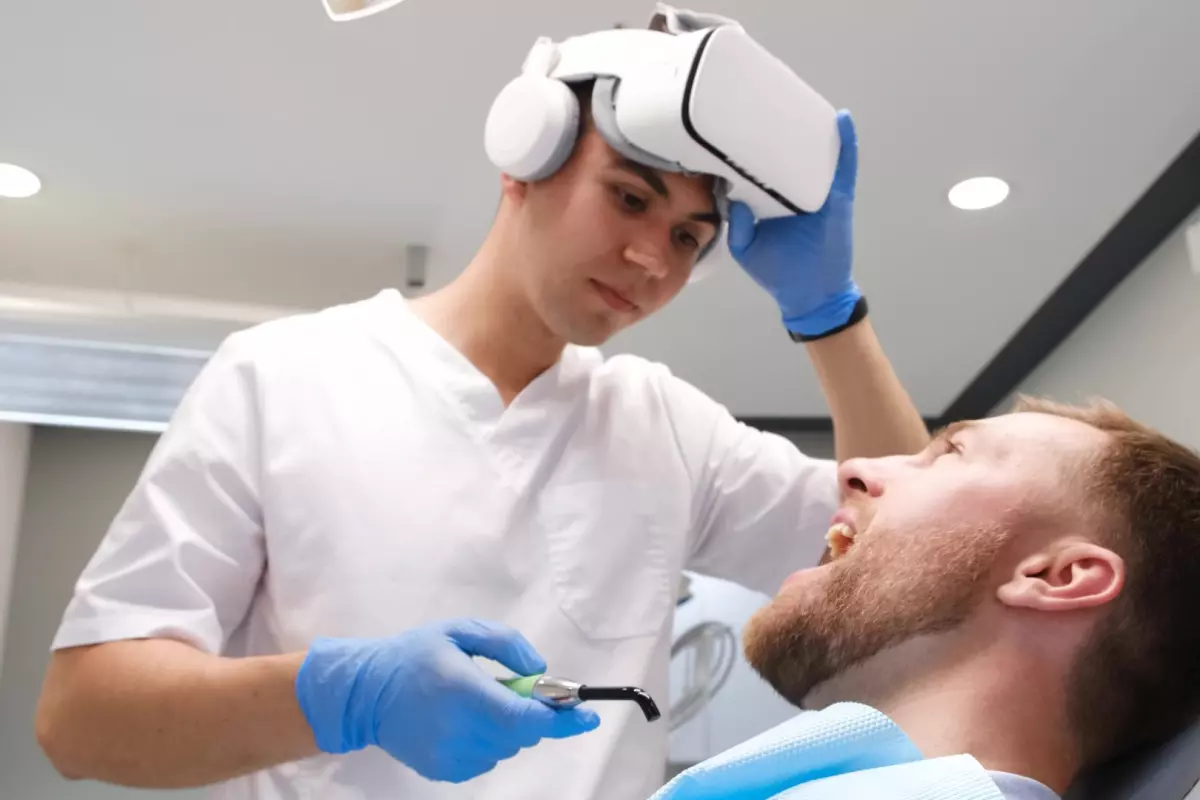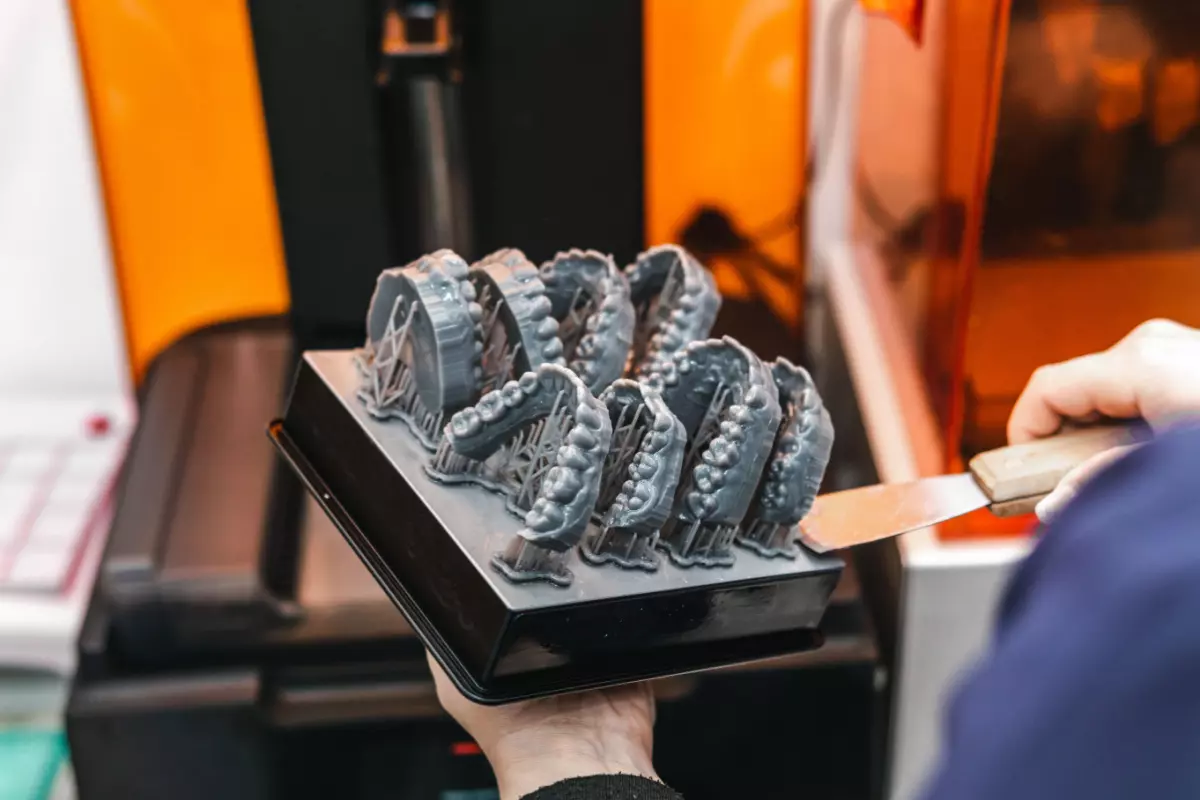The dental field is on the brink of a tech revolution to enhance patient experiences, streamline workflows, improve diagnostics, and broaden treatment options.
Think AI-assisted diagnosis, AR planning of procedures, teleindustry expansion for greater patient access, and robotics surpassing human accuracy.
However, the possibilities don’t stop there. This article delves into these innovations, discussing how they’re transforming the dental industry and what that means for your practice and patients.
What Are the Latest Advancements in Dentistry?
Oral healthcare is experiencing a remarkable transformation thanks to rapid advancements in dental technology. These groundbreaking innovations are reshaping the landscape of dental care, from the integration of artificial intelligence and augmented reality to the emergence of teledentistry and 3D printing.
Let’s take a look:
Artificial Intelligence (AI) in Dentistry
Artificial Intelligence (AI) is at the forefront of advances in dentistry. The ability of AI systems to analyze vast amounts of data and recognize patterns enables dentists to make more accurate and efficient clinical decisions.

Here are some specific examples:
- Diagnosis and Imaging: AI-enhanced imaging tools can help dentists detect oral diseases and abnormalities more accurately. By analyzing radiographs, intraoral scans, and photographs, AI algorithms can spot early signs of cavities, periodontal diseases, and oral cancers, boosting chances of early detection, timely intervention, and better treatment outcomes.
- Treatment Planning: AI algorithms can utilize patient records, medical history, and clinical data to formulate personalized treatment plans. Considering patient preferences, dental anatomy, and treatment success rates, these AI-powered systems offer evidence-based guidance for complex procedures, streamlining and enhancing treatment planning.
- Virtual Assistants: AI-backed virtual assistants can retrieve patient information, offer real-time chairside help, and assist in documentation. The instant access to patient records, treatment plans, and clinical guidelines allows these virtual assistants to support dentists promptly, ensuring precise and efficient dental procedures. This technology bolsters dental professionals’ ability to deliver quality treatment, enhancing patient safety and satisfaction.
- Predictive Analytics: AI algorithms analyze vast amounts of patient data, including medical and dental history, demographics, lifestyle factors, and clinical indicators. Recognizing patterns in this data, these algorithms predict oral health outcomes and identify higher-risk individuals. This enables dentists to proactively implement personalized preventive measures for better long-term oral health management.
Augmented Reality in Dentistry
Augmented Reality (AR) is a technology that overlays digital information, such as virtual images or data, onto the real world. It combines virtual elements with the physical world, allowing users to experience a blended reality that integrates digital and real-world components.

Latest dental trends include AR technology, potentially aiding the field of oral healthcare in the following ways:
- Enhanced Treatment Visualization: AR enables dentists to visualize complex dental procedures in real time. By wearing AR glasses or utilizing AR apps, dentists can superimpose digital models of teeth and gums onto a patient’s oral cavity. This visualization helps dentists plan treatments with greater precision, ensuring optimal results.
- Virtual Simulations: With AR, dental professionals can simulate treatment outcomes virtually. Dentists can create virtual models of the patient’s mouth, allowing them to try different treatment options and visualize the potential results. This empowers dentists to discuss treatment plans with patients, fostering better communication and shared decision-making.
- Improved Patient Education: AR technology enables dentists to educate patients about their oral health conditions and treatment options more effectively. Dentists can use AR visualizations to explain complex dental procedures, showcasing potential outcomes and expected results. This interactive approach enhances patient understanding, leading to more informed decisions and improved trust.
- Guided Surgical Procedures: AR can assist in guided surgical procedures, such as dental implant placements. Dentists can precisely locate implant sites using AR overlays, ensuring accurate implant positioning. This technology provides real-time guidance, reducing the margin of error and increasing the success rates of complex dental procedures.
- Continued Education: Dentists can use AR models for continuous learning and to keep abreast of new procedures and techniques. Dental professionals can enhance their skills, refine techniques, and stay engaged with complex cases by immersing themselves in augmented reality simulations and virtual training scenarios.
Teledentistry
Teledentistry is revolutionizing the future of dentistry by leveraging digital communication tools to deliver remote dental care. It uses telecommunication and virtual platforms to enable dental consultations, diagnosis, treatment planning, and patient monitoring. Here’s how teledentistry is transforming the field:
- Remote Consultations: Teledentistry allows dentists to connect with patients remotely, eliminating the need for in-person visits for initial consultations. Through video conferencing or online communication platforms, dentists can evaluate patients’ oral health, discuss concerns, and provide initial recommendations, saving time and improving accessibility.
- Access to Underserved Areas: Teledentistry expands access to dental care for individuals residing in remote or underserved areas. Patients can connect with dental professionals without the need to travel long distances, bridging the gap between patients and oral healthcare providers.
- Dental Triage and Diagnosis: Dentists can use teledentistry to remotely triage patients and determine the urgency of their dental conditions. Dentists can provide preliminary diagnoses and recommend appropriate treatment plans by evaluating patients’ symptoms and visual assessments through images or live video.
3D Printing in Dentistry
Within dentistry, 3D tech can be used to create dental models for study and planning, custom trays, orthodontic aligners, crowns, bridges, and even surgical guides for implant placement.
For dentists, 3D printing enhances accuracy, allows for increased customization, and reduces reliance on external labs – speeding up treatment times and reducing costs. For patients, the ability to print restorations in-office means fewer appointments and quicker results. Moreover, the precise fit of 3D-printed restorations can offer improved comfort and functionality.

Here are additional ways this technology could aid professionals in attracting new patients and improving satisfaction:
- Prosthetics and Restorations: 3D printing produces precise, customized dental prosthetics like crowns, bridges, and dentures. By replacing traditional mold-making with digital models, it boosts production accuracy, offering better-fitting, personalized restorations with improved aesthetics and function. It also reduces turnaround times, ensuring efficient delivery of dental prosthetics.
- Surgical Guides and Implants: 3D printing allows dentists to create custom surgical guides for accurate implant placement. It also enables the creation of patient-specific implants aligning perfectly with the patient’s anatomy, enhancing success rates and patient outcomes.
- Orthodontics and Aligners: 3D printing has transformed orthodontic treatments, particularly in clear aligner therapy. It allows for the production of sequential aligner trays that gradually move teeth into the desired position. 3D printing facilitates the customization and rapid production of aligners, making orthodontic treatments more efficient and comfortable for patients.
- Dental Models and Surgical Planning: Traditional dental models can be time-consuming and prone to inaccuracies. 3D printing offers a more precise and efficient method for producing dental models, which are used for treatment planning, orthodontic evaluations, and patient education.
Robotics in Dentistry
With the fusion of cutting-edge technologies and automated systems, robotics is revolutionizing various aspects of dental procedures and patient care. Here are just a few:
- Minimally Invasive Dentistry: Robotics enables dentists to perform minimally invasive procedures using smaller instruments and more precise movements. This approach preserves healthy tooth structure, reduces patient discomfort, and facilitates faster recovery.
- Laboratory Automation: Robotics is streamlining material handling, mixing, and fabricating dental appliances. Automated systems can efficiently produce crowns, bridges, and other dental prosthetics more accurately and consistently.
- Patient Assistance and Monitoring: Robotic assistants can help with patient positioning, instrument handling, and data collection during dental procedures. Additionally, robotic monitoring systems can track vital signs and provide real-time feedback to dentists, enhancing patient safety and comfort.
- Teleoperated Dentistry: Robotics also enables dentists to perform procedures remotely through teleoperated systems. This technology allows dentists to provide dental care to patients in remote locations, underserved areas, or in emergencies where immediate access to a dental professional is limited.
Regenerative Dentistry
Regenerative dentistry utilizes the body’s natural healing processes to restore and regenerate damaged or lost oral tissues and structures.

Here are a few innovations in this field:
- Tissue Engineering: As a significant breakthrough in regenerative dentistry, tissue engineering involves the lab creation of artificial oral tissues like bone, gum, and dental pulp using advanced biomaterials, growth factors, and stem cells. These can be customized to fit patients’ needs and integrate effortlessly into their natural oral structures.
- Stem Cell Therapy: Stem cells’ unique differentiation ability aids in regenerating diverse oral tissues. Utilizing their regenerative potential enables dentists to foster the growth of new bone, gum tissue, and dental pulp. Sourced from places like bone marrow or adipose tissue, stem cells present promising opportunities for repairing or replacing impaired or lost oral tissues.
- Growth Factors and Bioactive Materials: Growth factors are naturally occurring proteins that signal cells to divide, differentiate, and migrate, leading to tissue growth and repair. They can be applied directly to the treatment area or incorporated into scaffolds or membranes to enhance tissue regeneration.
- Repair and Renewal: Regenerative dentistry enhances treatment effectiveness for various oral conditions. For example, it can repair damaged gum tissue in periodontal disease, stimulate bone regeneration around teeth, and even foster complete tooth regrowth in cases of trauma or loss. By targeting root causes and encouraging tissue regeneration, this field aims to deliver more durable, aesthetically pleasing outcomes, enhancing oral health and functionality.
How To Be Prepared for the Future of Dentistry?
To be prepared for the future of dentistry, there are three key areas to keep in mind: staying informed, embracing digital dentistry, and expanding your skill set. Here’s a breakdown of how each of these aspects can benefit you and your patients:
- Stay Informed: The latest in dental technology, research, and treatments enables dentists to provide top-tier service with innovative solutions, enhancing patient outcomes and confidence. Opportunities like conferences, seminars, and continuing education programs offer direct insight into emerging industry trends. Subscriptions to reputable dental publications connect you with the larger community, allowing learning from peers and keeping your practice up to date with industry advancements.
- Embrace Digital Dentistry: Digital tools like cone-beam computed tomography (CBCT) and CAD/CAM technology boost diagnostic precision, treatment planning, and enable quicker, high-quality dental restorations. Intraoral scanners enhance patient comfort and accuracy. Adopting these digital solutions can heighten treatment effectiveness, increase efficiency, and improve patient retention. Keeping abreast of emerging technologies, such as AI-powered diagnostics, keeps your practice ahead, providing opportunities for better patient care and workflows.
- Expand Your Skill Set: Advanced training in areas like implantology, orthodontics, or cosmetic dentistry can broaden your treatment offerings. Skills in emerging fields like regenerative dentistry, teledentistry, and minimally invasive procedures leverage innovation for better patient outcomes. Continual skill expansion keeps you at the forefront of oral healthcare, solidifying your role as a trusted expert and providing comprehensive patient care. Expanding your expertise can positively impact your earning potential, as dentist salaries often reflect both specialization and experience.
Final Thoughts
By focusing on staying informed, embracing digital dentistry, and expanding your skill set, you will position yourself to thrive in the future of dentistry. These steps will enable you to provide cutting-edge care, maintain patient retention, and stay at the forefront of advancements in dental practice.


